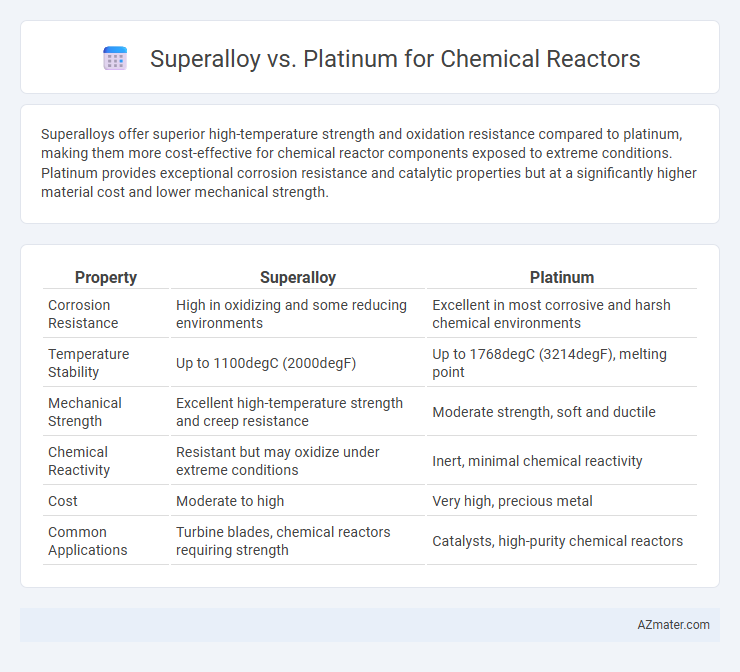Superalloys offer superior high-temperature strength and oxidation resistance compared to platinum, making them more cost-effective for chemical reactor components exposed to extreme conditions. Platinum provides exceptional corrosion resistance and catalytic properties but at a significantly higher material cost and lower mechanical strength.
Table of Comparison
| Property | Superalloy | Platinum |
|---|---|---|
| Corrosion Resistance | High in oxidizing and some reducing environments | Excellent in most corrosive and harsh chemical environments |
| Temperature Stability | Up to 1100degC (2000degF) | Up to 1768degC (3214degF), melting point |
| Mechanical Strength | Excellent high-temperature strength and creep resistance | Moderate strength, soft and ductile |
| Chemical Reactivity | Resistant but may oxidize under extreme conditions | Inert, minimal chemical reactivity |
| Cost | Moderate to high | Very high, precious metal |
| Common Applications | Turbine blades, chemical reactors requiring strength | Catalysts, high-purity chemical reactors |
Introduction to Chemical Reactor Materials
Superalloys and platinum are critical materials in chemical reactor construction due to their exceptional resistance to high temperatures and corrosive environments. Superalloys, typically based on nickel, cobalt, or iron, offer superior mechanical strength and oxidation resistance, making them ideal for high-stress applications. Platinum, valued for its exceptional catalytic properties and corrosion resistance, is often used in reactors where precise chemical reactions and longevity under harsh acidic conditions are required.
What are Superalloys?
Superalloys are advanced metal alloys primarily composed of nickel, cobalt, or iron, designed for exceptional strength, corrosion resistance, and stability at high temperatures commonly found in chemical reactors. These materials maintain mechanical integrity and resist oxidation and thermal degradation, making them ideal for harsh chemical processing environments where platinum may also be considered. Their superior creep resistance and resistance to chemical attack provide a cost-effective alternative to platinum for reactor components exposed to extreme operational conditions.
Platinum: Properties and Applications
Platinum exhibits exceptional chemical inertness, high melting point (1768degC), and excellent resistance to corrosion and oxidation, making it ideal for harsh chemical reactor environments. Its catalytic properties enhance reaction efficiency in processes such as hydrogenation and reforming, outperforming many superalloys in specific applications. Despite higher cost, platinum's durability and superior catalytic activity justify its use in precision chemical reactors where maximum performance and longevity are critical.
Mechanical Strength: Superalloy vs Platinum
Superalloys exhibit superior mechanical strength compared to platinum, maintaining structural integrity under high temperatures and corrosive environments typical of chemical reactors. Platinum, while chemically inert and highly resistant to corrosion, has lower tensile strength and is more prone to deformation under mechanical stress. These differences make superalloys preferable for reactor components subjected to intense mechanical loads and thermal cycling.
Corrosion and Oxidation Resistance
Superalloys exhibit superior corrosion resistance in high-temperature, aggressive chemical reactor environments due to their chromium and nickel content, forming stable oxide layers that protect the metal surface. Platinum, known for its exceptional oxidation resistance, maintains structural integrity in oxidizing atmospheres but is generally less resistant to certain corrosive chemicals like strong acids and halides compared to superalloys. Selection between superalloy and platinum depends on the specific reactor conditions, balancing chemical corrosion factors and oxidative stability to optimize performance and longevity.
Thermal Stability Comparison
Superalloys exhibit exceptional thermal stability with melting points typically ranging between 1300degC and 1450degC, enabling them to maintain strength and resist oxidation in extreme chemical reactor environments. Platinum, with a melting point of approximately 1768degC, offers superior resistance to high-temperature corrosion and thermal creep, making it ideal for processes involving extremely high and fluctuating temperatures. While superalloys provide mechanical robustness and cost efficiency, platinum's outstanding thermal stability and catalytic properties make it preferred for specialized high-temperature chemical reactors requiring sustained performance and durability.
Cost and Availability Considerations
Superalloys offer a cost-effective alternative to platinum in chemical reactors due to their lower raw material expenses and broader industrial availability. Platinum, despite its superior corrosion resistance and catalytic properties, remains prohibitively expensive and limited by scarcity, impacting large-scale reactor implementations. Selecting superalloys can balance performance and budget constraints, particularly in applications where ultra-high chemical inertness is not critical.
Catalytic Properties in Reactor Environments
Superalloys exhibit exceptional catalytic properties in chemical reactors due to their high-temperature strength and resistance to oxidation, making them suitable for harsh reactor environments. Platinum offers superior catalytic efficiency and selectivity in diverse reactions but is limited by higher cost and susceptibility to sintering under extreme conditions. In catalytic reactor environments, the choice between superalloy and platinum depends on balancing durability, catalytic activity, and operational temperature ranges.
Maintenance and Longevity Factors
Superalloys offer exceptional resistance to high-temperature corrosion and mechanical stress, significantly reducing maintenance frequency in chemical reactors exposed to harsh environments. Platinum, while highly corrosion-resistant and chemically inert, often requires more frequent inspections due to its susceptibility to mechanical wear and higher initial cost limits large-scale use. The longevity of superalloys typically surpasses platinum in reactors operating under extreme thermal cycling and oxidative conditions, making superalloys a cost-effective choice for sustained industrial applications.
Best Choice for Chemical Reactors: Superalloy or Platinum?
Superalloys offer superior mechanical strength, corrosion resistance, and high-temperature stability, making them ideal for chemical reactors operating under extreme conditions. Platinum, while highly resistant to chemical corrosion and excellent for catalytic processes, is cost-prohibitive and less durable under mechanical stress compared to superalloys. For most industrial chemical reactors, superalloys provide a more balanced combination of durability, performance, and cost-effectiveness than platinum.

Infographic: Superalloy vs Platinum for Chemical Reactor
 azmater.com
azmater.com